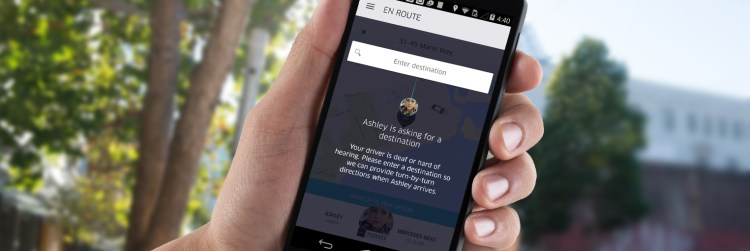Uber has frequently touted its service as benefiting both riders and drivers. From lowering the number of drunk driving cases to supporting our military veterans, the company has been quick to remind us of its positive impact on society. Today, it has a similar message, this time relating to those who are deaf or hearing impaired. Uber has formed a partnership with the Communication Service for the Deaf (CSD), one of the nation’s leading deaf-led nonprofits.
“We see technology as a humanizing experience,” said David Richter, Uber’s vice president of strategic initiatives. He remarked that the company’s platform is evolving and changes based on user feedback. The latest shift has established support mechanisms that allow deaf drivers to better communicate with passengers who can hear, while allowing them to continue having a flexible means of earning money.
Through its CSD partnership, Uber said that it’ll create online video guides in American Sign Language (ASL) and will also use the nonprofit’s ASL-based customer experience team to handle concerns and feedback from deaf and hearing-impaired drivers. To show that it has strong support from within the community, Uber will hold a series of “appreciation and sign up events” around the country, starting in Washington, D.C. on April 20 before branching out to San Francisco and other cities.

The bigger picture here is that Uber wants to open up its platform to more people, and there’s a vast opportunity within the deaf community. Richter said that 70 percent of hearing-impaired individuals in the U.S. are unemployed. Those who are already Uber drivers have earned more than $10 million through the platform, to date. Ryan Hutchison, vice president for CSD, told VentureBeat: “Limited by unequal and inaccessible training and learning resources, deaf people are unable to build the skills and knowledge to market themselves competitively for paid work opportunities.”
When Uber first launched, the company didn’t cater to the hearing impaired, but it has recently started tweaking its mobile app to make it friendlier to those impacted. When drivers indicate on the Uber app that they’re deaf, the screen will now flash when there’s a ride request — rather than beeping. Additionally, the voice functionality can be disabled, requiring that all communications be made by text. Lastly, passengers are notified in advance that their driver is deaf, which alleviates any awkwardness, and are prompted to enter their destination ahead of time.

The company isn’t alone in its efforts on this front, as Uber’s main competitor, Lyft, has also released features for deaf drivers. A Lyft spokesperson told us that its on-demand car service lets drivers text passengers to let them know that text is the preferred method of communication. It also has a support network for those with impaired hearing.
Alicia Johnson, an Uber driver from Washington, D.C., told us that in the past, she’d had to decline rides multiple times because she couldn’t answer the phone. She appreciates being able to text riders and thinks that the newest features are “great.” A longtime driver on the platform, Johnson knows firsthand what it was like before there was support: “I didn’t know what I was doing back then or what to expect. It’s a better experience now. It’s more visual and the riders know I’m deaf.”
“We’re not giving special perks to the deaf community,” Richter said, when speaking about the program; “We’re creating a level playing field.”
All of the functionality will be available globally, including the ASL-supported video guides and call center help. However, the outreach events are limited to the U.S. at this time.


